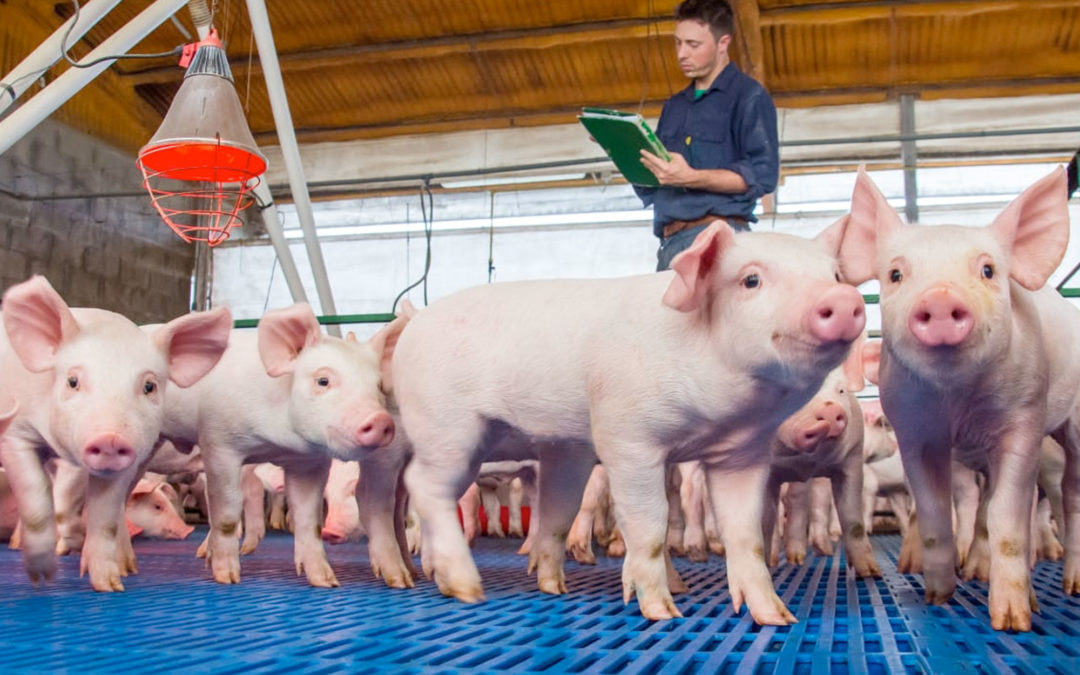The growing human population and the simultaneous increase in the demand for pork products has led to the development of large-scale intensive swine farming, thus increasing the risk of zoonotic diseases. This article will discuss new and emerging zoonotic diseases.
Zoonotic diseases have become more common due to various factors such as urbanisation, deforestation, tourism, zoos, climate change, and wildlife exploitation. As pig production is one of the most significant branches of the world’s livestock production, zoonoses of porcine origins seem to be of particular importance.
Zoonotic disease transmission
Various zoonosis of viral, bacterial, and parasitic origin can be transmitted from pigs to humans and affect public health. Disease transmission occurs in multiple ways including direct contact with an infected animal, and/or consuming infected pork which results in infections with severe clinical manifestations.
Swine influenza virus
Influenza A virus, a single-strand RNA virus, belongs to the Orthomyxoviridae family. Influenza A virus is marked by fast evolution due to antigenic changes caused by gradual accumulation of surface proteins mutation, and antigenic reassortment caused by shuffle and recombination of viral gene segments between different viruses. Pigs are considered as a “mixing vessel” for the virus as they are susceptible to infection with swine, avian, and human influenza A viruses. Therefore, when pigs are infected with at least 2 different viruses, the viral segments can interchange, recombine, and develop novel antigenic and biological features thus increasing the risk of developing new reassortants with pandemic potentials. The latest 3 influenza A pandemics in 1957, 1968, and 2009 were caused by reassortants of human and animal origin viruses. Influenza A virus is easily transmitted between humans and pigs due to a similar distribution pattern of virus receptors between these 2 species. Studies showed that pigs maintained in Europe constitute a reservoir for many influenza A virus variants characterising zoonotic and presumably pre-pandemic potential. The swine H1N1 and H3N2 viruses show higher affinity to human-type receptors and efficiently replicate in both porcine and human cells, thus they may have zoonotic potential.
Hepatitis E virus
Hepatitis E infection is an emerging zoonotic disease caused by Paslahepevirus balayani, a small, non-enveloped single-stranded RNA virus, from the Hepeviridae family. Humans are susceptible to infection with genotypes 1 to 4 of the virus and they are the main reservoir of genotypes 1 and 2 which are not zoonotic. In contrast, pigs are the main reservoir of genotypes 3 and 4 which are most often zoonotic and result from close contact with infected animals or ingesting contaminated food. Therefore, swine workers have higher hepatitis E virus seroprevalence than the general population. Originally, hepatitis E virus was not linked to animals, until in 1997 when the first pig hepatitis E virus strain with a similar genomic sequence to human hepatitis E virus was isolated suggesting that swine hepatitis E virus can exhibit zoonotic potential. Contaminated raw or undercooked pork products are one of the primary sources of infections with genotypes 3 and 4.
Nipah virus
Nipah virus, an RNA virus, belongs to the Mononegavirales order together with some other dangerous viruses such as Hendra, Ebola, or Marburg. Nipah is an emerging zoonotic disease with high mortality and high risk to public health worldwide. Nipah virus has the pandemic potential due to human susceptibility, the capacity of numerous virus strains for man-to-man transmission, and high mutation rates. The emergence of Nipah in pigs was simultaneous with pronounced respiratory and nervous symptoms in humans who had contact with infected pigs. The isolation of the same virus from both humans and pigs confirmed that this pathogen was responsible for infection in humans and pigs. Nipah transmission from pigs to humans occurs via the respiratory route or direct contact with animals and their fluid or secretion.
Trichinella spp.
Trichinella spp. are zoonotic parasites with a simple life cycle occurring within a single host, with no free-living stages. Trichinella spp. cause trichinellosis, a severe and sometimes fatal disease, in humans. Domestic and wild pigs represent the most significant reservoir of this nematode and consumption of raw or undercooked pork and pork products is the main cause of transmission to humans. Therefore, data regarding this infection in pigs are critical. Trichinella spp. infection in pigs is documented in numerous countries of all continents except for Antarctica. The transmission in pigs occurs via tail biting of infected pigs.
Yersinia enterocolitica
Yersinia enterocolitica is a Gram-negative, relatively anaerobic bacteria leading to Yersiniosis, a gastrointestinal infection, in various countries of most continents. Pigs are the main reservoir of this bacteria; however, they are often asymptomatic and do not develop any clinical signs of infection. Under cooked pork, and cross-contamination of other food or food-related items while handling raw pork are the main causes of human infection. Yersinia enterocolitica spreads among pigs through the faecal-oral route.
Erysipelothrix rhusiopathiae
Erysipelothrix rhusiopathiae is a facultatively anaerobic, gram-positive, non-spore-forming pathogen for multiple species of vertebrate and invertebrate animals. This bacterium is present in water, soil, and food products. Infections in humans occur after exposure to infected animals or their products due to skin injury. Therefore, veterinarians, abattoir workers, butchers, fishermen, fish handlers, and homemakers are at the most significant risk of infection. Erysipelothrix rhusiopathiae was initially known as a human pathogen and later it was identified as a pig pathogen. Erysipelothrix rhusiopathiae is highly prevalent and results in substantial economic loss. Due to environmental conditions and restrictions on antibiotic usage, this disease is re-emerging in pigs. Erysipelothrix rhusiopathiae spread in pigs via faeces, urine, saliva, and nasal secretions.
Further research
Due to the increase in demand for pork products around the world, zoonotic diseases of porcine origins are becoming of particular importance. Pigs can act as intermediate and amplifying hosts for diseases with pandemic potential including Swine influenza, Hepatitis E, Nipah, Trichinellosis, Yersiniosis, and Erysipelas. Therefore, further research is needed to find the proper One Health approaches to reduce the pandemic risk these pathogens pose.

